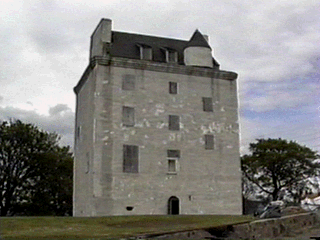

Law Castle, another of the Boyd castles that we know of, stands on a "law", or hill overlooking West Kilbride. It was built in 1468 for Princess Mary, daughter of James II, upon her marriage to Thomas, Master of Boyd, and later Earl of Arran. The castle is also called the Tower of Kilbride.
The tower is about the same size but of later design than the keep in Kilmarnock, as evidenced by the ground level door and the larger and more numerous windows. It was still built with defense in mind having few and tiny ground level windows, and a murderous gun loop to the left of the door. The parapet rested on corbels and there were open rounds on each corner.
When we arrived at the top of a winding lane, we found a group of workmen engaged in repairs to the driveway. Intriguingly, the door to the keep was standing open, raising our hopes of seeing inside. Approaching the workmen we soon found that the foreman, a middle aged man of medium build, was actually the owner.
He was a pleasant enough gentleman and quite willing to talk to Americans. He turned out to be a Sassenach (Englishman), who had bought the keep with the idea or retiring to a Scottish Castle. It was obvious that quite a lot of expense had recently gone into making the building weatherproof. The upper garret, described in recent books as collapsed, has been rebuilt and the outer walls "hulled", or stuccoed, and all of the window openings had been temporarily shielded with plywood.
Our host was frustrated by a lack of cooperation from the local population. They wanted to know "why are you repairing that monument to our oppressors?" The fact that he was English undoubtedly also contributed to his problems.
Our host did not invite us to tour the inside, so our knowledge of it comes from "The Castles of Scotland," by Maurice Lindsay, published by Constable and Company, Ltd, London. "The vaulted basement has two cellars, from that to the east a stair rises to the Hall above. The Hall on the first floor has a screened-off section with a wide fireplace which would have provided the kitchen. The second floor contains two rooms with garderobes and drains. There is a turnpike stair in the south- east angle, by the door."
Thomas's father, Lord Robert Boyd, was Regent of Scotland for James III. It was he who arranged the marriage of James III to the daughter of the King of Norway, who brought as her dowry the Orkneys and Shetlands, which thus became part of Scotland.
After the wedding, James, now eighteen, assumed control of his affairs. Like many a teenager, the young king resented most those who had best looked after his welfare, and so he moved against the Boyds, causing them to flee into exile in France. Thomas was accompanied into exile by his wife, the Princess Mary, who remained loyal to him and did not return to Scotland until after Thomas's death, years later on the continent.